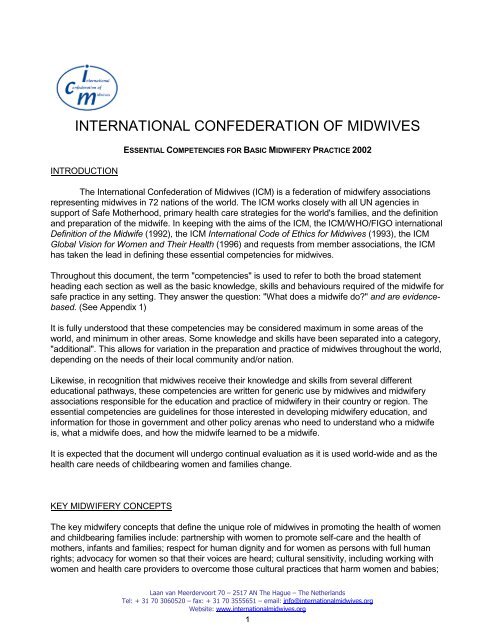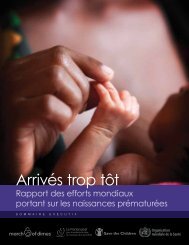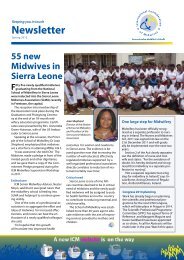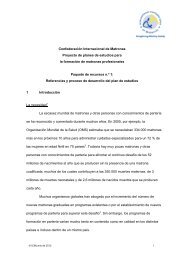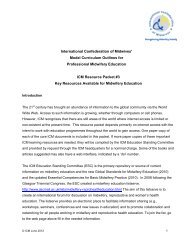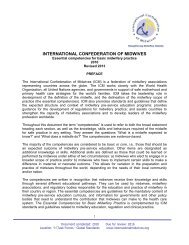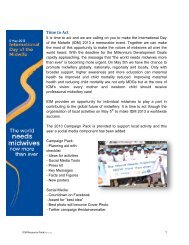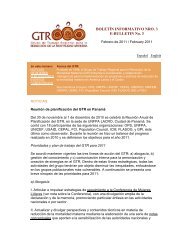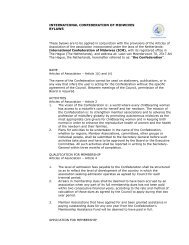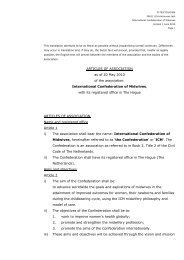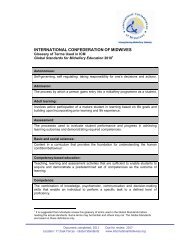Essential Competencies for Basic Midwifery Practice - International ...
Essential Competencies for Basic Midwifery Practice - International ...
Essential Competencies for Basic Midwifery Practice - International ...
You also want an ePaper? Increase the reach of your titles
YUMPU automatically turns print PDFs into web optimized ePapers that Google loves.
INTERNATIONAL CONFEDERATION OF MIDWIVESINTRODUCTIONESSENTIAL COMPETENCIES FOR BASIC MIDWIFERY PRACTICE 2002The <strong>International</strong> Confederation of Midwives (ICM) is a federation of midwifery associationsrepresenting midwives in 72 nations of the world. The ICM works closely with all UN agencies insupport of Safe Motherhood, primary health care strategies <strong>for</strong> the world's families, and the definitionand preparation of the midwife. In keeping with the aims of the ICM, the ICM/WHO/FIGO internationalDefinition of the Midwife (1992), the ICM <strong>International</strong> Code of Ethics <strong>for</strong> Midwives (1993), the ICMGlobal Vision <strong>for</strong> Women and Their Health (1996) and requests from member associations, the ICMhas taken the lead in defining these essential competencies <strong>for</strong> midwives.Throughout this document, the term "competencies" is used to refer to both the broad statementheading each section as well as the basic knowledge, skills and behaviours required of the midwife <strong>for</strong>safe practice in any setting. They answer the question: "What does a midwife do?" and are evidencebased.(See Appendix 1)It is fully understood that these competencies may be considered maximum in some areas of theworld, and minimum in other areas. Some knowledge and skills have been separated into a category,"additional". This allows <strong>for</strong> variation in the preparation and practice of midwives throughout the world,depending on the needs of their local community and/or nation.Likewise, in recognition that midwives receive their knowledge and skills from several differenteducational pathways, these competencies are written <strong>for</strong> generic use by midwives and midwiferyassociations responsible <strong>for</strong> the education and practice of midwifery in their country or region. Theessential competencies are guidelines <strong>for</strong> those interested in developing midwifery education, andin<strong>for</strong>mation <strong>for</strong> those in government and other policy arenas who need to understand who a midwifeis, what a midwife does, and how the midwife learned to be a midwife.It is expected that the document will undergo continual evaluation as it is used world-wide and as thehealth care needs of childbearing women and families change.KEY MIDWIFERY CONCEPTSThe key midwifery concepts that define the unique role of midwives in promoting the health of womenand childbearing families include: partnership with women to promote self-care and the health ofmothers, infants and families; respect <strong>for</strong> human dignity and <strong>for</strong> women as persons with full humanrights; advocacy <strong>for</strong> women so that their voices are heard; cultural sensitivity, including working withwomen and health care providers to overcome those cultural practices that harm women and babies;Laan van Meerdervoort 70 – 2517 AN The Hague – The NetherlandsTel: + 31 70 3060520 – fax: + 31 70 3555651 – email: info@internationalmidwives.orgWebsite: www.internationalmidwives.org1
a focus on health promotion and disease prevention which views pregnancy as a normal life event.Midwives recognise that equity of status <strong>for</strong> women will bring the greatest impact on global maternalchildhealth by ensuring adequate nutrition, clean water and sanitation; so they are committed to theimprovement of basic living conditions as well as providing competent midwifery services.SCOPE OF MIDWIFERY PRACTICEThe scope of midwifery practice used throughout this document is built upon the ICM/WHO/FIGOinternational Definition of the Midwife (1992). <strong>Midwifery</strong> practice includes the autonomous care of thegirl-child, the adolescent and the adult woman prior to, during and following pregnancy. This meansthat the midwife gives necessary supervision, care and advice <strong>for</strong> women during pregnancy, labourand the postpartum period. The midwife conducts deliveries on her own responsibility and cares <strong>for</strong>the newborn infant. This care includes primary health care supervision within the community(preventive measures); health counselling and education <strong>for</strong> women, the family and the communityincluding preparation <strong>for</strong> parenthood; the provision of family planning; the detection of abnormalconditions in the mother and child; the procurement of specialised assistance as necessary(consultation or referral); and the execution of primary and secondary emergency measures in theabsence of medical help. <strong>Midwifery</strong> practice is ideally conducted within a community-based healthcare system that may include traditional birth attendants, traditional healers, other community-basedhealth workers, doctors, nurses and specialists in referral centres.THE MIDWIFERY MODEL OF CAREThe <strong>Midwifery</strong> Model of Care is based on the premise that pregnancy and birth are normal life events.The <strong>Midwifery</strong> Model of Care includes: monitoring the physical, psychological, spiritual and social wellbeingof the woman and family throughout the childbearing cycle; providing the woman withindividualised education, counselling and antenatal care; continuous attendance during labour, birthand the immediate postpartum period; ongoing support during the postnatal period; minimisingtechnological interventions; and identifying and referring women who require obstetric or otherspecialist attention. This model of care is woman-centred and therein lies its accountability.Laan van Meerdervoort 70 – 2517 AN The Hague – The NetherlandsTel: + 31 70 3060520 – fax: + 31 70 3555651 – email: info@internationalmidwives.orgWebsite: www.internationalmidwives.org2
THE FRAMEWORK FOR DECISION-MAKING IN MIDWIFERY CAREMidwives assume responsibility and accountability <strong>for</strong> their practice, applying up-to-date knowledgeand skills in caring <strong>for</strong> each woman and family. The safety and overall well-being of the woman is of<strong>for</strong>emost concern to the midwife. The midwife strives to support a woman's in<strong>for</strong>med choices in thecontext of a safe experience. The midwife's decision-making process utilises a variety of sources ofknowledge and is dynamic, responding to the changing health status of each woman. Midwivesinvolve women and their families in all parts of the decision-making process and in developing a planof care <strong>for</strong> a healthy pregnancy and birth experience.STEP 1:STEP 2:STEP 3:STEP 4:STEP 5:Collect in<strong>for</strong>mation from the woman, from the woman's and the infant's records,and from any laboratory tests in a systematic way <strong>for</strong> a complete assessment.Identify actual or potential problems based on the correct interpretation of thein<strong>for</strong>mation gathered in Step 1.Develop a comprehensive plan of care with the woman and her family based onthe woman's or infant's needs and supported by the data collected.Carry out and continually update the plan of care within an appropriate timeframe.Evaluate the effectiveness of care given with the woman and her family,consider alternatives if unsuccessful, returning to STEP 1 to collect more dataand/or develop a new plan.GUIDING STATEMENT TO MEMBER ASSOCIATIONSThe essential competencies <strong>for</strong> basic midwifery practice that follow are based on the values, vision,strategies and actions used by those who attend to the health needs of women and childbearingfamilies. Member associations are encouraged to use this ICM statement of competencies, as neededin their countries, in the education, regulation and development of standards of practice <strong>for</strong> midwivesas well as in policies needed to strengthen midwifery.Laan van Meerdervoort 70 – 2517 AN The Hague – The NetherlandsTel: + 31 70 3060520 – fax: + 31 70 3555651 – email: info@internationalmidwives.orgWebsite: www.internationalmidwives.org3
ESSENTIAL COMPETENCIES FOR BASIC MIDWIFERY PRACTICEMAY 2002GENERIC KNOWLEDGE, SKILLS AND BEHAVIOURS FROM THE SOCIAL SCIENCES, PUBLICHEALTH AND THE HEALTH PROFESSIONSCompetency #1: Midwives have the requisite knowledge and skills from the social sciences,public health and ethics that <strong>for</strong>m the basis of high quality, culturally relevant, appropriatecare <strong>for</strong> women, newborn and childbearing families.<strong>Basic</strong> Knowledge and Skills:1. Respect <strong>for</strong> local culture (customs).2. Traditional and modern routine health practices (beneficial and harmful).3. Resources <strong>for</strong> alarm and transport (emergency care).4. Direct and indirect causes of maternal and neonatal mortality and morbidity in the localcommunity.5. Advocacy and empowerment strategies <strong>for</strong> women.6. Understanding human rights and their effect on health.7. Benefits and risks of available birth settings.8. Strategies <strong>for</strong> advocating with women <strong>for</strong> a variety of safe birth settings.9. Knowledge of the community - its state of health including water supply, housing,environmental hazards, food, common threats to health.10. Indications and procedures <strong>for</strong> adult and newborn/infant cardiopulmonary resuscitation.11. Ability to assemble, use and maintain equipment and supplies appropriate to setting ofpractice.Additional Knowledge and Skills12. Principles of epidemiology, sanitation, community diagnosis and vital statistics orrecords13. National and local health infrastructures; how to access needed resources <strong>for</strong>midwifery care.14. Principles of community-based primary care using health promotion and diseaseprevention strategies.15. National immunisation programs (provision of same or knowledge of how to assistcommunity members to access to immunisation services)Professional Behaviours - The midwife:1. Is responsible and accountable <strong>for</strong> clinical decisions.2. Maintains knowledge and skills in order to remain current in practice.3. Uses universal/standard precautions, infection control strategies and clean technique.4. Uses appropriate consultation and referral during care.5. Is non-judgmental and culturally respectful.6. Works in partnership with women and supports them in making in<strong>for</strong>med choicesabout their health.7. Uses appropriate communication skills.8. Works collaboratively with other health workers to improve the delivery of services toLaan van Meerdervoort 70 – 2517 AN The Hague – The NetherlandsTel: + 31 70 3060520 – fax: + 31 70 3555651 – email: info@internationalmidwives.orgWebsite: www.internationalmidwives.org4
women and families.PRE-PREGNANCY CARE AND FAMILY PLANNING METHODSCompetency #2: Midwives provide high quality, culturally sensitive health education andservices to all in the community in order to promote healthy family life, planned pregnanciesand positive parenting.<strong>Basic</strong> Knowledge of:1. Growth and development related to sexuality, sexual development and sexual activity.2. Female and male anatomy and physiology related to conception and reproduction.3. Cultural norms and practices surrounding sexuality, sexual practices and childbearing.4. Components of a health history, family history and relevant genetic history.5. Physical examination content and investigative laboratory studies that evaluatepotential <strong>for</strong> a healthy pregnancy.6. Health education content targeted to reproductive health, sexually transmittedinfections (STIs), HIV/AIDS and child survival.7. Natural methods <strong>for</strong> child spacing and other locally available and culturally acceptablemethods of family planning.8. Barrier, steroidal, mechanical, chemical and surgical methods of contraception andindications <strong>for</strong> use.9. Counselling methods <strong>for</strong> women needing to make decisions about methods of familyplanning.10. Signs and symptoms of urinary tract infection and common sexually transmittedinfections in the area.Additional Knowledge of:<strong>Basic</strong> Skills:11. Factors involved in decisions relating to unplanned or unwanted pregnancies.12. Indicators of common acute and chronic disease conditions specific to a geographicarea of the world, and referral process <strong>for</strong> further testing/ treatment.13. Indicators of and methods of counselling/referral <strong>for</strong> dysfunctional interpersonalrelationships including sexual problems, domestic violence, emotional abuse andphysical neglect.1. Take a comprehensive history.2. Per<strong>for</strong>m a physical examination focused on the presenting condition of the woman.3. Order and/or per<strong>for</strong>m and interpret common laboratory studies such as haematocrit,urinalysis or microscopy.4. Use health education and basic counselling skills appropriately.5. Provide locally available and culturally acceptable methods of family planning.6. Record findings, including what was done and what needs follow-up.Laan van Meerdervoort 70 – 2517 AN The Hague – The NetherlandsTel: + 31 70 3060520 – fax: + 31 70 3555651 – email: info@internationalmidwives.orgWebsite: www.internationalmidwives.org5
c. abnormal laboratory resultsd. infections such as sexually transmitted infections (STIs), vaginitis, urinary tract,upper respiratorye. fetal assessment in the post-term pregnancy20. Treat and/or collaboratively manage above variations from normal based upon localstandards and available resources.21. Per<strong>for</strong>m external version of breech presentation.CARE DURING LABOUR AND BIRTHCompetency #4: Midwives provide high quality, culturally sensitive care during labour,conduct a clean and safe delivery, and handle selected emergency situations to maximise thehealth of women and their newborn.<strong>Basic</strong> Knowledge of:<strong>Basic</strong> Skills:1. Physiology of labour.2. Anatomy of fetal skull, critical diameters and landmarks.3. Psychological and cultural aspects of labour and birth.4. Indicators that labour is beginning.5. Normal progression of labour and how to use the partograph or similar tool.6. Measures to assess fetal well-being in labour.7. Measures to assess maternal well-being in labour.8. Process of fetal passage [descent] through the pelvis during labour and birth.9. Com<strong>for</strong>t measures in labour: eg. family presence/assistance, positioning, hydration,emotional support, non-pharmacological methods of pain relief.10. Transition of newborn to extra-uterine life.11. Physical care of the newborn - breathing, warmth, feeding.12. Promotion of skin-to-skin contact of the newborn with mother when appropriate.13. Ways to support and promote uninterrupted [exclusive] breastfeeding.14. Physiological management of the 3rd stage of labour.15. Indications <strong>for</strong> emergency measures: eg. retained placenta, shoulder dystocia, atonicuterine bleeding, neonatal asphyxia.16. Indications <strong>for</strong> operative delivery: eg. fetal distress, cephalo-pelvic disproportion.17. Indicators of complications in labour: bleeding, labour arrest, malpresentation,eclampsia, maternal distress, fetal distress, infection, prolapsed cord.18. Principles of active management of 3rd stage of labour.1. Take a specific history and maternal vital signs in labour.2. Per<strong>for</strong>m a screening physical examination.3. Do a complete abdominal assessment <strong>for</strong> fetal position and descent.4. Time and assess the effectiveness of uterine contractions.5. Per<strong>for</strong>m a complete and accurate pelvic examination <strong>for</strong> dilation, descent, presentingpart, position, status of membranes, and adequacy of pelvis <strong>for</strong> baby.6. Follow progress of labour using the partograph or similar tool <strong>for</strong> recording.7. Provide psychological support <strong>for</strong> woman and family.8. Provide adequate hydration, nutrition and com<strong>for</strong>t measures during labour.Laan van Meerdervoort 70 – 2517 AN The Hague – The NetherlandsTel: + 31 70 3060520 – fax: + 31 70 3555651 – email: info@internationalmidwives.orgWebsite: www.internationalmidwives.org8
9. Provide <strong>for</strong> bladder care.10. Promptly identify abnormal labour patterns with appropriate and timely interventionand/or referral.11. Per<strong>for</strong>m appropriate hand manoeuvres <strong>for</strong> a vertex delivery.12. Manage a cord around the baby's neck at delivery.13. Cut an episiotomy if needed.14. Repair an episiotomy if needed.15. Support physiological management of the 3rd stage of labour.16. Conduct active management of the 3rd stage of labour including:a. Administration of uterotonic agentsb. Controlled cord tractionc. Uterine massage after delivery of the placenta, as appropriate17. Guard the uterus from inversion during 3rd stage of labour.18. Inspect the placenta and membranes <strong>for</strong> completeness.19. Estimate maternal blood loss.20. Inspect the vagina and cervix <strong>for</strong> lacerations.21. Repair vaginal/perineal lacerations and episiotomy.22. Manage postpartum haemorrhage.23. Provide a safe environment <strong>for</strong> mother and infant to promote attachment.24. Initiate breastfeeding as soon as possible after birth and support exclusivebreastfeeding.25. Per<strong>for</strong>m a screening physical examination of the newborn.26. Record findings including what was done and what needs follow-up.Additional Skills:27. Per<strong>for</strong>m appropriate hand manoeuvres <strong>for</strong> face and breech deliveries.28. Inject local anaesthesia.29. Apply vacuum extraction or <strong>for</strong>ceps.30. Manage malpresentation, shoulder dystocia, fetal distress initially.31. Identify and manage a prolapsed cord.32. Per<strong>for</strong>m manual removal of placenta.33. Identify and repair cervical lacerations.34. Per<strong>for</strong>m internal bimanual compression of the uterus to control bleeding.35. Insert intravenous line, draw bloods, per<strong>for</strong>m haematocrit and haemoglobin testing.36. Prescribe and/or administer pharmacological methods of pain relief when needed.37. Administer oxytocics appropriately <strong>for</strong> labour induction or augmentation and treatmentof postpartum bleeding.38. Transfer woman <strong>for</strong> additional/emergency care in a timely manner.POSTNATAL CARE OF WOMENCompetency #5: Midwives provide comprehensive, high quality, culturally sensitive postnatalcare <strong>for</strong> women.<strong>Basic</strong> Knowledge of:1. Normal process of involution and healing following delivery [including after an abortion].Laan van Meerdervoort 70 – 2517 AN The Hague – The NetherlandsTel: + 31 70 3060520 – fax: + 31 70 3555651 – email: info@internationalmidwives.orgWebsite: www.internationalmidwives.org9
2. Process of lactation and common variations including engorgement, lack of milksupply, etc.3. Maternal nutrition, rest, activity and physiological needs (eg. bladder).4. Infant nutritional needs.5. Parent-infant bonding and attachment; eg. how to promote positive relationships.6. Indicators of sub-involution eg. persistent uterine bleeding, infection.7. Indications of breastfeeding problems.8. Signs and symptoms of life threatening conditions; eg. persistent vaginal bleeding,urinary retention, incontinence of faeces, postpartum pre-eclampsia.Additional Knowledge of:<strong>Basic</strong> Skills:9. Indicators of selected complications in the postnatal period: eg. persistent anaemia,haematoma, embolism, mastitis, depression, thrombophlebitis.10. Care and counselling needs during and after abortion.11. Signs and symptoms of abortion complications.1. Take a selective history, including details of pregnancy, labour and birth.2. Per<strong>for</strong>m a focused physical examination of the mother.3. Assess <strong>for</strong> uterine involution and healing of lacerations/repairs.4. Initiate and support uninterrupted [exclusive] breastfeeding.5. Educate mother on care of self and infant after delivery including rest and nutrition.6. Identify haematoma and refer <strong>for</strong> care as appropriate.7. Identify maternal infection, treat or refer <strong>for</strong> treatment as appropriate.8. Record findings including what was done and what needs follow-up.Additional Skills:9. Counsel woman/family on sexuality and family planning post delivery.10. Counsel and support woman who is post-abortion.11. Evacuate a haematoma.12. Provide appropriate antibiotic treatment <strong>for</strong> infection.13. Refer <strong>for</strong> selected complications.NEWBORN CARE (up to 2 months of age)Competency #6: Midwives provide high quality, comprehensive care <strong>for</strong> the essentially healthyinfant from birth to two months of age.<strong>Basic</strong> Knowledge of:1. Newborn adaptation to extra-uterine life.2. <strong>Basic</strong> needs of newborn: airway, warmth, nutrition, bonding.3. Elements of assessment of the immediate condition of newborn; eg. APGAR scoringsystem <strong>for</strong> breathing, heart rate, reflexes, muscle tone and colour.4. <strong>Basic</strong> newborn appearance and behaviours.Laan van Meerdervoort 70 – 2517 AN The Hague – The NetherlandsTel: + 31 70 3060520 – fax: + 31 70 3555651 – email: info@internationalmidwives.orgWebsite: www.internationalmidwives.org10
5. Normal newborn and infant growth and development.6. Selected variations in the normal newborn; eg. caput, moulding, mongolian spots,haemangiomas, hypoglycaemia, hypothermia, dehydration, infection.7. Elements of health promotion and prevention of disease in newborn and infants.8. Immunisation needs, risks and benefits <strong>for</strong> the infant up to 2 months of age.Additional Knowledge of:<strong>Basic</strong> Skills:9. Selected newborn complications, eg. jaundice, haematoma, adverse moulding of thefetal skull, cerebral irritation, non-accidental injuries, causes of sudden infant death.10. Normal growth and development of the preterm infant up to 2 months of age.1. Clear airway to maintain respirations.2. Maintain warmth but avoid overheating.3. Assess the immediate condition of the newborn; eg. APGAR scoring or otherassessment method.4. Per<strong>for</strong>m a screening physical examination of the newborn <strong>for</strong> conditions incompatiblewith life.5. Position the infant <strong>for</strong> breastfeeding.6. Educate parents about danger signs and when to bring the infant <strong>for</strong> care.7. Begin emergency measures <strong>for</strong> respiratory distress (newborn resuscitation),hypothermia, hypoglycaemia, cardiac arrest.8. Transfer newborn to emergency care facility when available.9. Record findings, including what was done and what needs follow-up.Additional Skills:10. Per<strong>for</strong>m a gestational age assessment11. Educate parents about normal growth and development, child care.12. Assist parents to access community resources available to the family.13. Support parents during grieving process <strong>for</strong> congenital birth defects, loss of pregnancy,or neonatal death.14. Support parents during transport/transfer of newborn.15. Support parents with multiple births.Appendix 1. Background to the evidence-base of the competenciesBetween 1995 and 1999 a modified Delphi Technique was carried out <strong>for</strong> seven rounds to establishthe Provisional <strong>Essential</strong> <strong>Competencies</strong> <strong>for</strong> <strong>Basic</strong> <strong>Midwifery</strong> <strong>Practice</strong>. As agreed by the <strong>International</strong>Council (the Confederation’s governing body) in 1999, the competencies were field-tested by 17 ICMmember associations throughout 2001. The extensive field testing was undertaken by 1,271practising midwives, 77 educator groups (total of 312 educators), and 79 senior level midwiferystudent groups (total of 333 individuals) from 22 countries; and 25 regulators from 20 countries. Atotal of 214 individual competency statements within six domains were presented <strong>for</strong> considerationLaan van Meerdervoort 70 – 2517 AN The Hague – The NetherlandsTel: + 31 70 3060520 – fax: + 31 70 3555651 – email: info@internationalmidwives.orgWebsite: www.internationalmidwives.org11
and comment. Almost all of the competencies were supported by a great majority of thepersons/groups involved in the testing, with many receiving universal support. In April 2002 the ICM<strong>International</strong> Council discussed and adopted the <strong>Essential</strong> <strong>Competencies</strong> <strong>for</strong> <strong>Basic</strong> <strong>Midwifery</strong><strong>Practice</strong>, therewith establishing it as an official ICM document.Laan van Meerdervoort 70 – 2517 AN The Hague – The NetherlandsTel: + 31 70 3060520 – fax: + 31 70 3555651 – email: info@internationalmidwives.orgWebsite: www.internationalmidwives.org12


